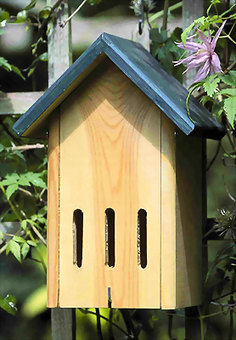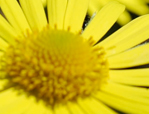
Who Lives in a Butterfly Hibernation House?
In the late summer of 1995, David Wisnieski of Pennsylvania Furnace, PA, constructed 40 butterfly houses for the Dept. of Entomology, PSU, as part of the requirements for his Eagle Scout Badge. The design was similar to that of standard bluebird houses, which can be opened, inspected, and cleaned, except that the entry opening was a slit rather than hole with a perch below. Also, the boxes were specially insulated and provided with pieces of corrugated cardboard for roosts for the adult butterflies.
In late August, the houses were attached on the south-facing sides of large trees of a variety of species at a height of four to five feet, along woodland trails at Shaver’s Creek Environmental Center (Stone Valley), Penn State, Huntingdon Co., PA. The houses were opened on a sunny day in early March of 1996 and 1997 to check for over-wintering butterflies.
Four species of angelwings, the Mourning Cloak, Compton Tortoise Shell, Hop Merchant, and Question Mark, overwinter at Shaver’s Creek and would be the most likely users of butterfly houses. All were observed flying in late March and at other times during the year. Of these, the Mourning Cloak is the most common.
In March of 1996, no butterflies were recorded occupying any of the hibernation houses. There was no evidence of occupancy by any arthropods whatsoever, except for the presence of a spider silk in 20% of the houses. Probably because the houses had been put out late in the summer, they were not greatly used by other species.
In March of 1997, the houses were checked for a second season. Again no butterflies were present. However, there was evidence that the houses had been used by other insects and spiders during the summer of 1996. Spider webs and silk were observed in 65%of the houses. In most cases, the web construction was typical of a funnel weaver (Agelenidae: Agelenopsis pennsylvanica). This species builds flat sheet-like webs in lawns or attached to buildings around windows, etc. The spiders characteristically rest in a funnel-like tube attached to the main web. The mature female spiders lay eggs in the fall and die with the coming of winter.
The abandoned nests of umbrella wasps (Vespidae: Polistes sp.) were found in 17.5% of the houses. Two of the houses had brood chambers of mud dauber wasps (Sphecidae: Sceliphron sp). Three houses had numbers of overwintering cluster flies (Calliphoridae: Pollenis rudis). Two houses had been used by the Gypsy moth (Lymantria dispar) for pupation. One had a colony of ants (Foprmicidae: Monomorium sp.). Two houses had dead stink bugs (Pentatomidae: Brochymena sp.).
The most unusual stranger using a butterfly house was evidenced by a large nest, occupying about a quarter of the interior, composed mostly of black locust leaves. For a short time one house had been occupied by a white-footed mouse (Peromyscus leucopus). It couldn’t have been a very stout one, because the slit opening of the butterfly house was about a quarter inch in width: there was no evidence of gnawing to increase the size of the opening. Finally, eight houses had nothing whatsoever inside. I have yet to see evidence to support the notion that butterflies actually need or use butterfly houses. My suggestion is, if you want to do something useful for butterflies, “build them a mud puddle.”
Occupants of Butterfly Houses
Number of Houses built in 1995 & attached to south-facing sides of large trees at 5’ height - 40
Overwintering March 1996 number of butterflies occupying houses - 0
Percent of other species or residue indicated in houses March 1996 - 20% of houses had spider silk
Overwintering March 1997 number of butterflies occupying houses - 0
Percent of other species or residue indicated in houses March 1997 - 65% houses had spider webs & spider silk; 17.5% or less of the houses had nests of umbrella wasps, brood chambers of mud dauber wasps, over-wintering cluster flies, gypsy moths, ant colonies and stink bugs. One house had evidence of a white mouse.
In the late summer of 1995, David Wisnieski of Pennsylvania Furnace, PA, constructed 40 butterfly houses for the Dept. of Entomology, PSU, as part of the requirements for his Eagle Scout Badge. The design was similar to that of standard bluebird houses, which can be opened, inspected, and cleaned, except that the entry opening was a slit rather than hole with a perch below. Also, the boxes were specially insulated and provided with pieces of corrugated cardboard for roosts for the adult butterflies.
In late August, the houses were attached on the south-facing sides of large trees of a variety of species at a height of four to five feet, along woodland trails at Shaver’s Creek Environmental Center (Stone Valley), Penn State, Huntingdon Co., PA. The houses were opened on a sunny day in early March of 1996 and 1997 to check for over-wintering butterflies.
Four species of angelwings, the Mourning Cloak, Compton Tortoise Shell, Hop Merchant, and Question Mark, overwinter at Shaver’s Creek and would be the most likely users of butterfly houses. All were observed flying in late March and at other times during the year. Of these, the Mourning Cloak is the most common.
In March of 1996, no butterflies were recorded occupying any of the hibernation houses. There was no evidence of occupancy by any arthropods whatsoever, except for the presence of a spider silk in 20% of the houses. Probably because the houses had been put out late in the summer, they were not greatly used by other species.
In March of 1997, the houses were checked for a second season. Again no butterflies were present. However, there was evidence that the houses had been used by other insects and spiders during the summer of 1996. Spider webs and silk were observed in 65%of the houses. In most cases, the web construction was typical of a funnel weaver (Agelenidae: Agelenopsis pennsylvanica). This species builds flat sheet-like webs in lawns or attached to buildings around windows, etc. The spiders characteristically rest in a funnel-like tube attached to the main web. The mature female spiders lay eggs in the fall and die with the coming of winter.
The abandoned nests of umbrella wasps (Vespidae: Polistes sp.) were found in 17.5% of the houses. Two of the houses had brood chambers of mud dauber wasps (Sphecidae: Sceliphron sp). Three houses had numbers of overwintering cluster flies (Calliphoridae: Pollenis rudis). Two houses had been used by the Gypsy moth (Lymantria dispar) for pupation. One had a colony of ants (Foprmicidae: Monomorium sp.). Two houses had dead stink bugs (Pentatomidae: Brochymena sp.).
The most unusual stranger using a butterfly house was evidenced by a large nest, occupying about a quarter of the interior, composed mostly of black locust leaves. For a short time one house had been occupied by a white-footed mouse (Peromyscus leucopus). It couldn’t have been a very stout one, because the slit opening of the butterfly house was about a quarter inch in width: there was no evidence of gnawing to increase the size of the opening. Finally, eight houses had nothing whatsoever inside. I have yet to see evidence to support the notion that butterflies actually need or use butterfly houses. My suggestion is, if you want to do something useful for butterflies, “build them a mud puddle.”
Occupants of Butterfly Houses
Number of Houses built in 1995 & attached to south-facing sides of large trees at 5’ height - 40
Overwintering March 1996 number of butterflies occupying houses - 0
Percent of other species or residue indicated in houses March 1996 - 20% of houses had spider silk
Overwintering March 1997 number of butterflies occupying houses - 0
Percent of other species or residue indicated in houses March 1997 - 65% houses had spider webs & spider silk; 17.5% or less of the houses had nests of umbrella wasps, brood chambers of mud dauber wasps, over-wintering cluster flies, gypsy moths, ant colonies and stink bugs. One house had evidence of a white mouse.

